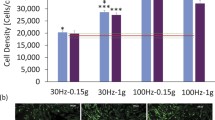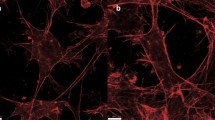Abstract
Biomechanical force is one of the major epigenetic factors that determine the form and differentiation of skeletal tissues. In this study, osteoblastic cells UMR-106 were exposed to compressive forces at 1000 μstrain and 4000 μstrain via a four-point bending system, and analyzed by MTT and LSCM techniques. Cell proliferation activity decreased shortly after loading but recovered to normal levels within 24 h. And the cytoskeleton depolymerized at first, but then gradually repolymerized. To find out the role of cytoskeleton in mechanotransduction, we examined the relationship between cytoskeleton construction and c-fos expression. A transient stress-induced upregulation in c-fos mRNA and c-Fos protein was discovered when cells were exposed to physiological forces. And the upregulation in c-fos expression was blocked by cytochalasin D (Depolymerizing agent of microfilament). It gave clues that the organization of cytoskeleton was an important link in transcriptional control in response to low-mechanical stimulation.







Similar content being viewed by others
References
Ducy P, Schinke T, Karsenty G (2000) The osteoblast: a sophisticated fibroblast under central surveillance. Science 289:1501–1504
Katsumi A, Orr AW, Tzima E et al (2004) Integrins in mechanotransduction. J Biol Chem 279:12001–12004
Hughes-Fulford M, Fitzgerald J (1999) Mechanically induced c-fos expression is mediated by cAMP in M3T3-E1osteoblasts. FASEB J 13:553–557
Akisaka T, Yoshida H, Inoue S et al (2001) Organization of cytoskeletal F-actin, G-actin, and gelsolin in the adhesion structures in cultured osteoclast. J Bone Miner Res 16:1248–1255
Hughes-Fulford M, Lewis ML (1996) Effects of microgravity on osteoblast growth activation. Exp Cell Res 224:103–109
Meazzini MC, Toma CD, Schaffer JL et al (1998) Osteoblast cytoskeletal modulation in response to mechanical strain in vitro. J Orthop Res 16:170–180
Carvalho RS, Bumann A, Schaffer JL et al (2002) Predominant integrin ligands expressed by osteoblasts show preferential regulation in response to both cell adhesion and mechanical perturbation. J Cell Biochem 84:497–508
Chaudhuri O, Parekh SH, Fletcher DA (2007) Reversible stress softening of actin networks. Nature 445:295–298
Brown TD. (2000) Techniques for mechanical stimulation of cells in vitro: a review. J Biomech 33:3–14
Bottlang M, Simnacher M, Schmidt H et al (1997) A cell strain system for small homogeneous strain applications. Biomed Tech 42:305–309
Neidlinger-Wilke C, Grood ES, Wang JHC et al (2001) Cell alignment is induced by cyclic changes in cell length: studies of cells grown in cyclically stretched substrates. J Orthop Res 19:286–293
Claes LE, Heigele CA, Neidlinger-Wilke C et al (1998) Effects of mechanical factors on the fracture healing process. Clin Orthop Relat Res 355(Suppl):S132–147
Sato K, Adachi T, Matsuo M et al (2005) Quantitative evaluation of threshold fiber strain that induces reorganization of cytoskeletal actin fiber structure in osteoblastic cells. J Biomech 38:1895–1901
Charras GT, Horton MA (2002) Single cell mechanotransduction and its modulation analyzed by atomic force microscope indentation. Biophys J 82:2970–2981
Formigli L, Meacci E, Sassoli C et al (2007) Cytoskeleton/stretch-activated ion channel interaction regulates myogenic differentiation of skeletal myoblasts. J Cell Physiol 211:296–306
Tkach V, Tulchinsky E, Lukanidin E et al (2003) Role of the Fos family members, c-Fos, Fra-1 and Fra-2, in the regulation of cell motility. Oncogene 22:5045–5054
Huang FM, Chou MY, Chang YC (2003) Dentin bonding agents induce c-fos and c-jun protooncogenes expression in human gingival fibroblasts. Biomaterials 24:157–163
Wagner EF, Eferl R (2005) Fos/AP-1 proteins in bone and the immune system. Immunol Rev 208:126–140
Liu J, Liu T, Zheng Y et al (2006) Early responses of osteoblast-like cells to different mechanical signals through various signaling pathways. Biochem Biophys Res Commun 348:1167–1173
Li J, Zhao ZH, Chen GP et al (2007) A new four-point bending system to supply cultured adhensive cells in vitro with cyclic uniaxial strain. Key Eng Mat 330–332:1133–1136
Owan I, Burr DB, Turner CH et al (1997) Mechanotransduction in bone: osteoblasts are more responsive to fluid forces than mechanical strain. Am J Physiol-Cell Physiol 42:C810–C815
Knippenberg M, Helder MN, Doulabi BZ et al (2005) Adipose tissue-derived mesenchymal stem cells acquire bone cell-like responsiveness to fluid shear stress on osteogenic stimulation. Tissue Eng 11:1780–1788
Reuner KH, Wiederhold M, Schlegel K et al (1995) Autoregulation of actin synthesis by physiological alterations of the G-actin level in hepatocytes. Eur J Clin Chem Clin Biochem 33:569–574
Geng WD, Boskovic G, Fultz ME, et al (2001) Regulation of expression and activity of four PKC isozymes in confluent and mechanically stimulated UMR-108 osteoblastic cells. J Cell Physiol 189:216–228
Kamioka H, Honjo T, Takano-Yamamoto T (2001) A three-dimensional distribution of osteocyte processes revealed by the combination of confocal laser scanning microscopy and differential interference contrast microscopy. Bone 28:145–149
Rubin J, Rubin C, Jacobs CR (2006) Molecular pathways mediating mechanical signaling in bone. Gene 367:1–16
Ignatius A, Blessing H, Liedert A et al (2005) Tissue engineering of bone: effects of mechanical strain on osteoblastic cells in type I collagen matrices. Biomaterials 26:311–318
Stanford CM, Stevens JW, Brand RA (1995) Cellular deformation reversibly depresses RT-PCR detectable levels of bone-related mRNA. J Biomech 28:1419–1427
Neidlinger-Wilke C, Wilke HJ, Claes L (1994) Cyclic stretching of human osteoblasts affects proliferation and metabolism: a new experimental method and its application. J Orthop Res 12:70–78
Kaspar D, Seidl W, Neidlinger-Wilke C et al (2002) Proliferation of human-derived osteoblast-like cells depends on the cycle number and frequency of uniaxial strain. J Biomech 35:873–880
Horikawa A, Okada K, Sato K et al (2000) Morphological changes in osteoblastic cells (MC3T3-E1) due to fluid shear stress: cellular damage by prolonged application of fluid shear stress. Tohoku J Exp Med 191:127–137
Bur DB, Milgrom C, Fyhrie D et al (1996) In vivo measurement of human tibial strains during vigorous activity. Bone 18:405–410
Jiang CJ, Weeds AG, Khan S et al (1997) F-actin and G-actin binding are uncoupled by mutation of conserved tyrosine residues in maize actin depolymerizing factor (ZmADF). Proc Natl Acad Sci USA 94:9973–9978
Machesky LM, Insall RH (1999) Signaling to actin dynamics. J Cell Biol 146:267–272
James MF, Manchanda N, Gonzalez-Agosti C et al (2001) The neurofibromatosis 2 protein product merlin selectively binds F-actin but not G-actin, and stabilizes the filaments through a lateral association. Biochem J 356:377–386
Manfred S (1982) Action of cytochalasin D on cytoskeletal networks. J Cell Biol 92:79–91
Acknowledgements
This work was supported by grants from the National Nature Science Foundation of China (39800145).
Author information
Authors and Affiliations
Corresponding author
Rights and permissions
About this article
Cite this article
Li, J., Chen, G., Zheng, L. et al. Osteoblast cytoskeletal modulation in response to compressive stress at physiological levels. Mol Cell Biochem 304, 45–52 (2007). https://doi.org/10.1007/s11010-007-9484-8
Received:
Accepted:
Published:
Issue Date:
DOI: https://doi.org/10.1007/s11010-007-9484-8




